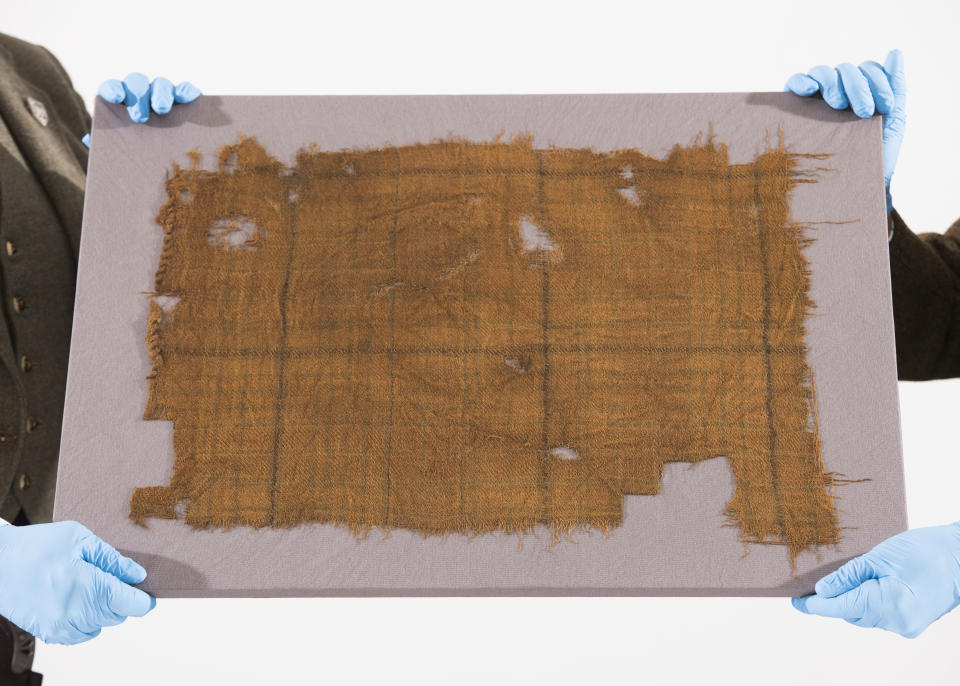Oldest tartan in Scotland to go on public display for first time
A tartan thought to be the oldest in Scotland will be displayed in a new exhibition from next month.
The plaid textile discovered in a peat bog in Glen Affric, in the Scottish Highlands, around 40 years ago is believed to have been created around the James I and Mary Queen of Scots era, meaning it dates back to the 16th century at the earliest.
The Scottish Tartans Authority (STA) commissioned dye analysis and radiocarbon testing on the woollen textile to prove its age.

It identified four initial colours of green, brown and possibly red and yellow.
The dye analysis confirmed the use of indigo or woad in the green but was inconclusive for the other colours, likely due to the dyestuff having degraded.
But no artificial or semi-synthetic dyestuffs were involved in the making of the tartan, leading researchers to believe it predates the 1750s.
Experts have said the tartan was more than likely worn as an “outdoor working garment” and would not have been worn by royalty.

A broad range of between 1500 and 1655 was identified, but the period of 1500 to 1600 was most probable, the STA said.
This makes it the oldest known piece of true tartan discovered in Scotland.
Due to the location it was found in, it has been dubbed the Glen Affric tartan. It measures around 55cm by 43cm.
It will go on public display at the Dundee design museum from April 1 to January 14 2024.
Peter MacDonald, head of research and collections at the Scottish Tartans Authority, said: “The testing process has taken nearly six months but the effort was well worth it and we are thrilled with the results.
Coming soon…🤩
Tartan celebrates one of the world's best-known textiles, exploring its ability to connect and divide communities, embrace tradition, express revolt, and inspire great works of design.
Opening 1 April, book now. Members & kids go free.https://t.co/Uflo1cC3w2 pic.twitter.com/vNeuacbmqh
— V&A Dundee (@VADundee) February 24, 2023
“In Scotland, surviving examples of old textiles are rare as the soil is not conducive to their survival. As the piece was buried in peat, meaning it had no exposure to air and it was therefore preserved.
“The tartan has several colours with multiple stripes of different sizes, and so it corresponds to what people would think of as a true tartan.
“Although we can theorise about the Glen Affric tartan, it’s important that we don’t construct history around it. Although Clan Chisholm controlled that area, we cannot attribute the tartan to them as we don’t know who owned it.
“The potential presence of red, a colour that Gaels consider a status symbol, is interesting because of the more rustic nature of the cloth.
“This piece is not something you would associate with a king or someone of high status, it is more likely to be an outdoor working garment.”
John McLeish, chair of the STA, said the tartan’s “historical significance” likely dates to the reigns of James V, Mary Queen of Scots or James VI/I – between 1513 and 1625.
James Wylie, curator at V&A Dundee, said: “We knew the Scottish Tartans Authority had a tremendous archive of material and we initially approached them to ask if them if they knew of any examples of ‘proto-tartans’ that could be loaned to the exhibition.
“I’m delighted the exhibition has encouraged further exploration into this plaid portion and very thankful for the Scottish Tartans Authority’s backing and support for uncovering such a historic find.
“To be able to exhibit the Glen Affric tartan is immensely important in the understanding of the textile traditions from which modern tartan derives, and I’m sure visitors will appreciate seeing this on public display for the very first time.”

 Yahoo News
Yahoo News 
